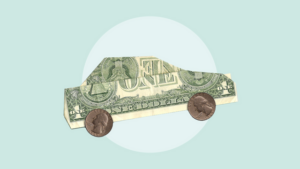Study: Americans spend most on gas in unlikely places

Where are Americans spending the most on gas in the U.S.? The answer may surprise you.
Expensive states like California and Washington are notorious for their high gas prices, but there’s another part of the equation that is often overlooked: average annual mileage.
A new analysis by Bankrate of AAA and Federal Highway Administration data found that Americans spend more on gas on average in more affordable states, such as Indiana, Wyoming and Missouri, than in states with higher gas prices like California and Washington.
The reason? Drivers in those low-cost states tend to spend a lot more time on the road, burning more gasoline than their counterparts in high-cost states. Drivers in Indiana, for example, average nearly 20,600 miles and shell out nearly $3,000 on gas annually, while drivers in California drive roughly 11,400 miles and spend about $2,000 per year on gas, according to Bankrate’s Hidden Costs of Car Ownership Study.
Whether you live in a high- or low-cost gasoline state, our analysis suggests there may be ways to cut back on the amount that you pay at the pump. Here’s where Americans are spending the most and least on gas across the country based on their driving habits, plus tips on how to spend less on fuel.
Gas expenditures can be a surprising hidden cost of car ownership, especially for drivers living in more rural areas where their daily travels are spread out over a larger area.— Shannon Martin, Bankrate insurance analyst
Drivers are spending the most on gas in Indiana, Wyoming and Missouri
Gas prices matter to the extent that you’re driving. The more driving you do, the more you’ll spend on gas, even if the price per gallon is cheaper in your state compared to other states.
According to Bankrate’s calculations, drivers in Indiana ($2,913), Wyoming ($2,765) and Missouri ($2,279) have the highest average gas costs per year. Residents in Indiana, Wyoming and Missouri tend to drive more and, therefore, spend more on gas annually. The 10 states with the highest annual gas costs tend to have a lower cost of living and lower gas prices at the pump, with the exception of Indiana.
The average price for a gallon of regular gas was $3.68 in Indiana, $3.33 in Wyoming and $3.20 in Missouri as of late July, but here’s how many miles people are driving on average in those states, according to 2022 Federal Highway Administration data:
- Wyoming: 21,588 miles
- Indiana: 20,560 miles
- Missouri: 18,514 miles
Comparatively, drivers in the District of Columbia ($956), Rhode Island ($1,314) and New York ($1,329) have the lowest average gas costs per year. Residents in those states are driving significantly less on average per year:
- District of Columbia: 6,695 miles
- New York: 9,548 miles
- Washington: 9,819 miles
As of late July, the average price for a gallon of regular gas in the District of Columbia was $3.71, $3.62 in New York and $4.25 in Washington.
What about states with high gas prices like California and Washington?
There’s no denying that gas prices are higher in certain parts of the country, like California and the Pacific Northwest. As of late July, the average price for a gallon of regular gas in those parts of the country hovered between $4.66 and $4.25 — the highest in the country.
But that doesn’t mean residents of those states are shelling out more for gas. In fact, people in California, Oregon, and Washington spend less on gas on average because they drive less. A variety of factors, like fuel costs, public transportation and density, account for the big differences between driving habits in each state.
Californians drive 11,409 miles per year, which is about 2,187 miles less than the average American motorist and 10,179 miles less than their counterparts in Wyoming. People also drive less in the Pacific Northwest, averaging 9,819 miles per year in Washington and 11,780 miles per year in Oregon.
Assuming that the average car in the U.S. travels about 26 miles on a gallon of gas, Californians average roughly $2,043 per year on gas. Drivers in Washington and Oregon spend a little less than that on average: $1,605 and $1,790 annually, respectively.
Gas prices have been trending down across the country over the last few months due to falling oil prices. The national average for a gallon of regular gas hovered around $3.50 as of late July, similar to the price in June, according to AAA data. A year ago, the national price of regular gas was around $3.85 per gallon.
“Oil prices have fallen quite a bit lately. In April, a barrel of oil was in the upper $80s, but today, it is $10 a barrel cheaper,” Andrew Gross, AAA spokesperson, said in a statement in July. “That might mitigate any upward pressure on pump prices.”
See where your state ranks for annual gas costs
How to save money at the gas pump
Consider incorporating these five hacks into your day-to-day to keep your gas expenses down.
1. Shop around: If you’re turning into the first gas station you see, you’re likely leaving money on the table. Instead, be proactive and research the lowest-priced options near you through free gas apps like GasBuddy, Gas Guru and AAA. These apps can tell you where the lowest gas prices are no matter where you are in the country, and you can sort results by fuel grade, distance and price.
2. Join a rewards program: If you’re loyal to a particular gas station near you, consider joining its rewards program if it has one. Many grocery stores and popular gas stations, like Exxon Mobil and Shell, offer rewards for filling up at their stations. The incentives may be small, but they could add up to big savings over time.
3. Consider paying with cash: It may be wise to keep cash on hand for gas, especially when traveling long distances by car. Some stations offer lower gas prices if you pay with cash instead of a debit or credit card. The difference is usually small, between 5 to 10 cents, but that can build up to tangible savings if you’re consistently paying lower gas prices with cash.
4. Leverage a cash back credit card: Another way to save at the pump is by using a cash back credit card. While you won’t be able to snag lower gas prices with a credit card, the gas rewards you earn could lead to more savings when you fill up at the pump. Several credit cards offer as much as 3 percent cash back at gas stations, which can equate to hundreds of dollars back in your pocket annually if you’re using the card responsibly.
5. Consider mass transit: The most straightforward way to save at the pump is to take advantage of public transportation when convenient instead of driving. If you do have to drive somewhere, be strategic about bundling your errands together to save on fuel.
Why we ask for feedback Your feedback helps us improve our content and services. It takes less than a minute to complete.
Your responses are anonymous and will only be used for improving our website.






